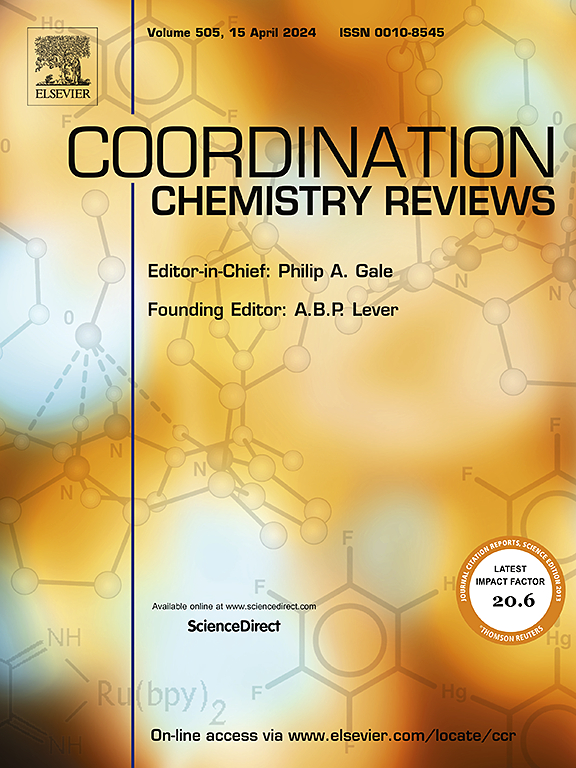A comprehensive review on pyrazole derivatives as corrosion inhibitors: Ligand properties, coordination bonding, and interfacial adsorption
IF 20.3
1区 化学
Q1 CHEMISTRY, INORGANIC & NUCLEAR
引用次数: 0
Abstract
Metal corrosion poses a critical challenge across industrial sectors, driving the persistent search for efficient, environmentally friendly, and non-toxic inhibitors. Pyrazole and its derivatives, as five-membered nitrogen-containing heterocyclic compounds, have garnered significant interest due to their robust coordination capabilities and superior corrosion inhibition performance. Nitrogen atoms and delocalized π-electrons in the pyrazole (C3H4N2) ring facilitate strong adsorption onto metal surfaces, forming protective hydrophobic layers that mitigate corrosion. This adsorption primarily involves a combination of physisorption and chemisorption, with the dominant mechanism depending on the metal-electrolyte system and functional groups present in the pyrazole derivatives. The presence of two vicinal (1,2-) nitrogen atoms makes the pyrazole ring an electron-rich species, offering strong coordination bonding and excellent ligand and coordinating properties through π-electron interaction. Their non-innocent ligand property, which allows them to donate and accept electrons, makes them capable of robust binding and adsorption on metallic substrates. The presence of additional functional moieties and their tautomeric flexibility enhance their capacity to provide adequate surface adsorption and coverage. These inhibitors exhibit remarkable inhibition efficiencies, manifesting as much as 98 % efficiency. This article examines pyrazole derivatives' capacity to suppress corrosion, particularly their electrical effects, ligand characteristics, coordination bonding, and interfacial characteristics. On metallic substrates such as Fe, Al, Zn, Cu, and galvanized-Fe, it talks about how stable and effective these derivatives are. With an emphasis on pyranopyrazoles, the study also discusses the sustainability and green features of pyrazole-based corrosion inhibitors. To enhance adsorption and inhibitory potential, it also covers chemical functionalisation and synergism techniques.

吡唑类缓蚀剂的研究进展:配体性质、配位键和界面吸附
金属腐蚀是整个工业领域面临的严峻挑战,促使人们不断寻找高效、环保、无毒的抑制剂。吡唑及其衍生物作为五元含氮杂环化合物,由于其强大的配位能力和优异的缓蚀性能而引起了人们的极大兴趣。吡唑(C3H4N2)环中的氮原子和离域π电子有利于在金属表面的强吸附,形成保护性疏水层,减轻腐蚀。这种吸附主要涉及物理吸附和化学吸附的结合,其主要机制取决于金属-电解质体系和吡唑衍生物中存在的官能团。两个相邻的(1,2-)氮原子的存在使得吡唑环成为富电子物质,通过π-电子相互作用提供了强的配位键和优异的配位性能。它们的非无害配体性质,使它们能够提供和接受电子,使它们能够在金属底物上牢固地结合和吸附。附加功能基团的存在及其互变异构的灵活性增强了它们提供足够表面吸附和覆盖的能力。这些抑制剂表现出显著的抑制效率,表现出高达98%的效率。本文研究了吡唑衍生物抑制腐蚀的能力,特别是它们的电效应、配体特征、配位键和界面特征。在金属衬底上,如铁、铝、锌、铜和镀锌铁,讨论了这些衍生物的稳定性和有效性。以吡喃吡唑为重点,研究还讨论了吡喃吡唑基缓蚀剂的可持续性和绿色特性。为了增强吸附和抑制潜力,它还涵盖了化学功能化和协同作用技术。
本文章由计算机程序翻译,如有差异,请以英文原文为准。
求助全文
约1分钟内获得全文
求助全文
来源期刊

Coordination Chemistry Reviews
化学-无机化学与核化学
CiteScore
34.30
自引率
5.30%
发文量
457
审稿时长
54 days
期刊介绍:
Coordination Chemistry Reviews offers rapid publication of review articles on current and significant topics in coordination chemistry, encompassing organometallic, supramolecular, theoretical, and bioinorganic chemistry. It also covers catalysis, materials chemistry, and metal-organic frameworks from a coordination chemistry perspective. Reviews summarize recent developments or discuss specific techniques, welcoming contributions from both established and emerging researchers.
The journal releases special issues on timely subjects, including those featuring contributions from specific regions or conferences. Occasional full-length book articles are also featured. Additionally, special volumes cover annual reviews of main group chemistry, transition metal group chemistry, and organometallic chemistry. These comprehensive reviews are vital resources for those engaged in coordination chemistry, further establishing Coordination Chemistry Reviews as a hub for insightful surveys in inorganic and physical inorganic chemistry.
 求助内容:
求助内容: 应助结果提醒方式:
应助结果提醒方式:


